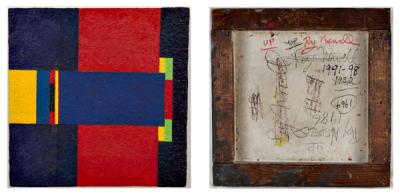Roy Newell in Springs

Those who wonder what Albert Pinkham Ryder’s work might have looked like mashed up with the 20th century will enjoy “Color and Time: Paintings by Roy Newell 1956-2000” at the Pollock-Krasner House and Study Center.
The year span of the exhibition sums it up all too well, as the artist was a persistent re-visitor to his oil on panel paintings, so much so that he was known to ask collectors for a piece back so he might continue to work on it. His paintings are dated with multiple years, and long intervals of years that the artist himself painstakingly tracked on the back of the painting. Clearly it was important to him to know and understand what he might have been thinking the last time he had approached the panel.
He was an irascible sort who didn’t play well with dealers or anyone else, and as a result, the geometrically abstract paintings he made were not widely shown. Like many who are now being rediscovered from that era, he was one of those contemporaries and friends of the de Koonings and Jackson Pollock and Lee Krasner who was lost to history. But it was indeed history’s loss, as this artist has much to tell us about color, balance, and purity of both form and vision.
Seeing the simple and mostly repetitive rectangular forms, from wide expanses to the narrowest blips, it was surprising that the artist gave some panels allusive names such as “Dance,” “Eden,” “Elegy,” and “Glory,” among others. Just as often, though, he did not title them, leaving them to speak for themselves.
He may not have had many friends, but he valued the camaraderie of certain fellow artists and was a regular habitue of the Eighth Street Artists Club and the Cedar Tavern, a popular mid-20th century artist haunt in Greenwich Village. Two of his friends there, Willem de Kooning and Franz Kline, were honored by Newell in tribute paintings. “Memorial,” which is on view in the show, was painted for Kline and is a model of deliberation as told by the dates provided for the painting.
Kline died in 1962 but was memorialized in paint by Newell beginning in 1988. That’s a long interval of deliberation, yet it didn’t stop there. The panel was worked on yet again in 1992 and again in 2000. Newell did a similar tribute to Willem de Kooning, but it is in the collection of Harrison Ford. Helen Harrison, director of the Pollock-Krasner House, said she approached Mr. Ford about the piece due to its significance as a reflection of how important his relationship to the de Koonings, both Bill and Elaine, was to him. He asked for a week to think about it. When she contacted him again, he said he couldn’t part with it for the three to six months it would take for the piece to be included in one or two of its venues. Newell’s collectors tend to be a devoted bunch once they discover him, Ms. Harrison said.
We don’t need a major motion picture star to tell us the value of these paintings. It is apparent the moment you step into the first floor of the house. With nature at its peak on a sunny July day over Accabonac Harbor just outside, few objects could rival the region’s unique natural beauty we all have been craving for months. Still, those first few moments with the paintings are a knockout. They feature mostly rich colors with a faded velvety texture that has also been likened to felt by the show’s curator, Robert Harrist.
Greens and blues are prime players, but Newell’s use of orange, yellow, and funkier shades of purple play worthy foils. There is also a lot of black and brown, but not too much white, although it is there in small amounts. What really grabs you, though, is the texture and the raised and sometimes uneven surface of these paintings. The shadows of colors that preceded those on view are often evident, as if the artist was offering the viewer an index to the painting’s previous incarnations and a blatant hint that there was much going on beneath the surface. In the show’s richly illustrated catalogue, with an essay befitting this 20th-century master manqué now trouvé, there are photographs catching some of the paintings’ earlier iterations to give a sense of the artist’s process and how he evolved over the years.
It seems more than coincidental that the artist would find himself living in Ryder’s former studio. Newell may share affinities with Hans Hofmann or Josef Albers and anticipate the style of some Minimalists, but none of those comparisons are as satisfying as Ryder’s, given their artistic eccentricities, rich tonalities, and urges to rework their paintings.
According to Mr. Harrist, Newell shared none of the philosophical or social theories of earlier geometric abstractionists such as Piet Mondrian. His use of recurring geometric relations were also not terribly precise or formulaic, although his compositions do seem to reference the ratio of the golden section.
It was the artist, himself, who also claimed the most affinity with Ryder, calling him “a metaphysical painter like me,” according to Harrist, who noted both artists’ attraction to “the watery realm,” as Newell called it.
The show will be on view through July 26.
